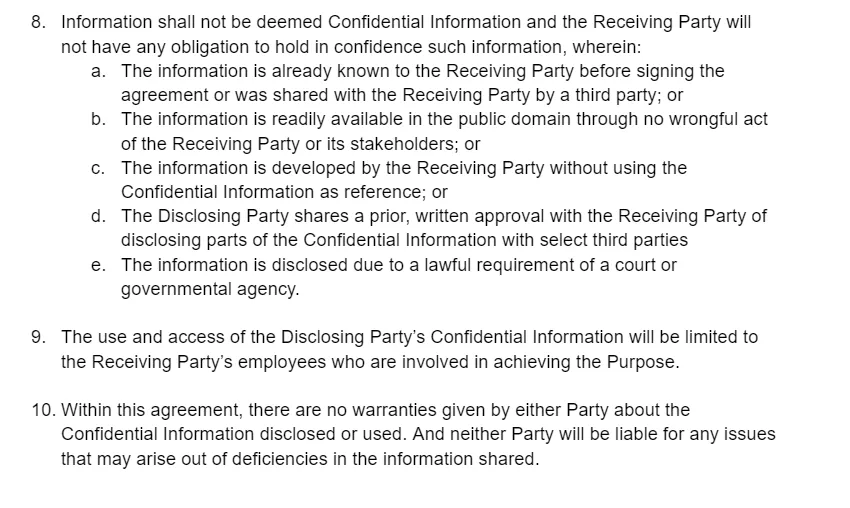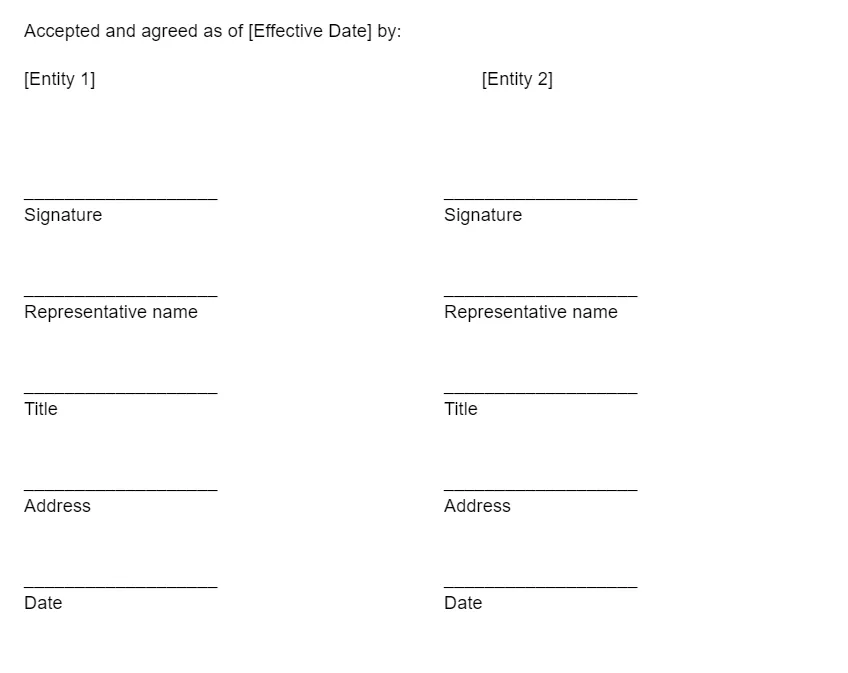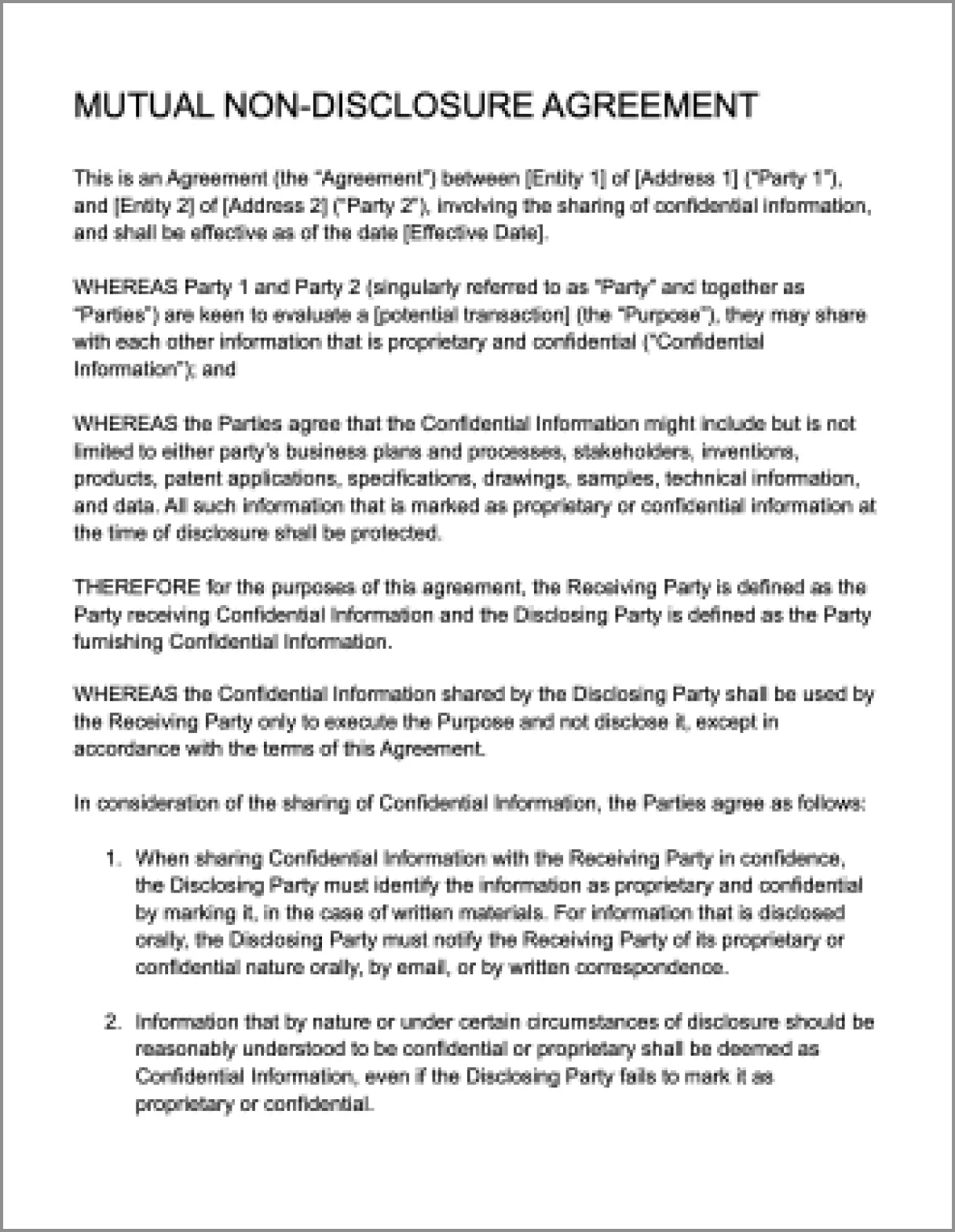Mutual Non-Disclosure Agreement Template
Is your company looking to enter into a new business relationship? If so, you'll need to protect the confidential material or information of both parties by executing a Mutual Non-Disclosure Agreement.
This document ensures that each entity’s unique ideas and other sensitive information isn't stolen or misused.
Below, you will find everything there is to know about mutual non disclosure contracts. Instead of crafting this agreement from scratch and potentially missing an important clause, use Signeasy’s Mutual Non-Disclosure Agreement template that is available for free download.
How to sign a Mutual Non-Disclosure Agreement?
- Collect details regarding the confidential information that will be exchanged by the parties.
- Input the project-specific information into the template contract.
- Upload the personalized contract to Signeasy.
- Choose the Sign Document option.
- Click on the Sign button.
- Choose to draw, type, or upload the signature of your choice.
- Click Finish to complete the online signing of the document.
What is a mutual non disclosure agreement?
A mutual NDA is a type of confidentiality agreement entered into by two or more parties (businesses or individuals). It helps them control the sharing of proprietary information and restrict its usage.
Under this contract’s parameters of confidentiality, both parties agree not to disclose the other’s confidential or proprietary information. In the event that the agreement is violated, the aggrieved party has the right to take legal action against the defaulter.
In this case, the aggrieved party may also claim compensation for lost profits or business opportunities.
How to create a mutual NDA
Do you plan on sharing and receiving confidential information when dealing with another party? Then it's time to ink a mutual NDA.
For a water-tight legal framework that safeguards the interests of both parties, choose a template that covers the following important clauses:
- Overview
In this first section, you set the scene for the agreement. Not only do you introduce the parties involved, but also the nature of the transaction.
It also serves to define the basic role of the disclosing party and the receiving party. Since this is a mutual NDA, both parties end up filling the role of the disclosing and receiving party.
You will need to outline the types of information that the receiving party is not permitted to disclose, such as:
- Trade secrets: Special formulas, practices, technical designs, blueprints, customer lists, and patent details
- Business ventures: Affiliate deals, mergers, audits, pricing, business, and financial records
- Creative materials: Documentary, TV, film, illustrations, web design, prototypes, or product samples

- Core obligations of the parties
This is one of the most important sections of the mutual NDA agreement, as it details the responsibilities of the receiving party and disclosing party.
At the very least, the clauses should address these factors:
- How to tag and identify confidential information
- The time that the information stays confidential, from the date of disclosure
- Ownership details of the disclosed information
- How to communicate, the need to keep the information confidential with relevant stakeholders
- Terms under which the receiving party can create or acquire similar products/information
Here is an example of the clauses that detail various obligations of the parties:

You could also add a non-circumvention provision to the contract. This bars both parties from directly doing business with each other's business contacts. If needed, you can include other clauses such as non-disclosure of transaction, non-solicitation, and non-compete.
- Exclusions
There are some instances wherein the NDA cannot protect the parties' confidential information.
For example, if the information is already out in the public domain or if the disclosing party has given written permission to share the information. In the snapshot below, you will find more examples of other such scenarios:

- Breach and warranties
The mutual non disclosure contract should explicitly state the consequences of not honoring the terms of the agreement. It is also helpful to have a clause that mentions the absence of warranty on the completeness and accuracy of the confidential information disclosed.

- Must-have general provisions
Some clauses are standard across many types of agreements. These tend to reduce the number of legal loopholes.
Some of the commonly used clauses that you may include in the mutual non disclosure agreement are:
- Entire agreement
- Arbitration
- Severability
- Counterparts
- Jurisdiction
- Effective date

- Signatures
Finally, for the mutual NDA to be legal and binding, representatives from both parties will need to sign it.
Printing out the document, getting all of the required parties to sign, then scanning and sending these documents can be highly inconvenient, especially during a pandemic.
Execution of the Agreement: This section outlines the procedures for executing the Mutual Non-Disclosure Agreement. It specifies the conditions under which the agreement becomes valid and legally binding, typically upon the signatures of both parties. It may also provide instructions or options for executing the agreement, such as physical signatures, electronic signatures, or other agreed-upon methods.
Signatory Details: In this subsection, the necessary information of the individuals who will be signing the agreement on behalf of their respective parties is captured. It typically includes their full names, titles or positions, and contact information. This ensures proper identification and representation of the parties involved. It may also include additional information, such as the authority of the signatories to bind their organizations to the agreement.
Date of Execution: The date of execution section records the date when the Mutual Non-Disclosure Agreement is officially signed by both parties. This date serves as a reference point for determining the effective date of the agreement and establishes the timeline for various obligations and provisions outlined within the agreement. The date of execution is typically placed below the signatory details, providing clarity and establishing a complete record of the agreement.
The easiest way to sign an NDA is using an eSignature solution like Signeasy that digitizes the approval process.

Why do you need a MNDA?
Confidentiality is the essence of establishing trust.
Especially for businesses engaging in joint ventures, mergers, or corporate takeovers, a mutual non disclosure agreement is key to a stress-free relationship. It also safeguards your trade secrets from being leaked to third parties or the public.
This contract is most commonly used between business partners, vendors, and consultants.
Top tips for writing a non disclosure agreement
- Use a mutual NDA template to speed up the contract execution. You may personalize the template with your specific information and context.
- There’s no single law that governs the protection of sensitive information and trade secrets. So, get a legal consultant and tailor the mutual NDA contract to the local laws. There tend to be differences in the degree of specificity, reasonableness, and even in formalities from jurisdiction to jurisdiction.
- Be clear about who owns the information once it's disclosed.
- Define how to identify and disclose confidential information to avoid ambiguity.
- Define the period for which the information must remain confidential.
- Upload the final contract to Signeasy to fast-track the signing process and keep online copies of the approved contract.
Mutual Non-Disclosure Agreement Template FAQs
How do you write a mutual non-disclosure agreement?
When you need to legally establish a confidential relationship between different entities that are likely to exchange sensitive information, you need to sign a non-disclosure agreement.
How do you validate a mutual NDA?
Writing the entire agreement from scratch can be a time-consuming process. Instead, you can simply personalize Signeasy’s easy-to-use mutual NDA template by filling the placeholder text with the transaction or relationship-specific details.
What is the difference between an NDA and a mutual NDA?
A unilateral NDA requires only one party to safeguard the other’s confidential information. Meanwhile, a mutual NDA requires all involved parties to protect each other’s sensitive information.
What makes an NDA mutual?
If two (or more) parties plan to share sensitive, technical, or commercial information, then a mutual NDA is required to protect their information.
What do you look for in a mutual non disclosure agreement?
- Details of parties involved in the information exchange
- Identification of the reason for the NDA
- Identification of the types of information that the parties categorize as confidential
- Duration of the agreement
- Obligations of the receiving party
- Remedies in case of breach of agreement
- Other boilerplate clauses
Template Preview
